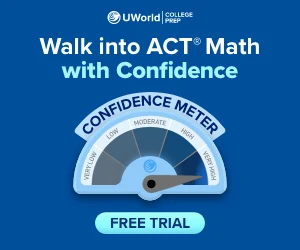Why Grammar Matters on the ACT
Grammar plays a major role in the ACT® English section, with nearly half the questions testing your grasp of standard English conventions. Mastering ACT English grammar rules can significantly boost your score in less time compared to other sections. These questions are straightforward once you know what to look for. A strong understanding of grammar not only helps you eliminate wrong answers confidently but also builds the foundation for efficient ACT grammar practice and strategic test-taking.
Most Common ACT Grammar Rules You Must Know
This section is your go-to reference for mastering the ACT grammar rules that show up again and again on the test. Knowing these high-impact topics will help you spot patterns and apply the right rules quickly during ACT grammar practice.
Subject-Verb Agreement
Subject-verb agreement means the subject and verb in a sentence must match in number—a singular subject takes a singular verb, and a plural subject takes a plural verb. This may sound simple, but the ACT often adds phrases or modifiers that distract from the true subject. Here are some important ACT grammar tips related to subject-verb agreement:
Ignore Prepositional Phrases Between Subject and Verb
Prepositional phrases (like of the students, in the room, with the tools) don’t affect the verb.
✅ The list of items is on the desk.
❌ The list of items are on the desk.
("List" is the subject, not "items.")
-
Compound Subjects Joined by “and” Are Plural
Two subjects joined by and typically take a plural verb.
✅ The coach and the players have agreed on a strategy.
❌ The coach and the players has agreed on a strategy.
(Both "coach" and "players" make the subject plural, so the verb should be have.)
-
Subjects Joined by “or” or “nor” Agree with the Closer Subject
With either/or, neither/nor, the verb agrees with the subject closest to it.
✅ Neither the manager nor the employees were available.
❌ Neither the manager nor the employees was available.
("Employees" is closer and plural, so use were.)
✅ Either the lights or the heater is broken.
❌ Either the lights or the heater are broken.
("Heater" is closer and singular, so use is.)
-
Indefinite Pronouns Can Be Singular or Plural
Some pronouns are always singular, others are plural. Be sure to memorize these patterns.
✅ Everyone is welcome to join the trip.
❌ Everyone are welcome to join the trip.
("Everyone" is singular.)
✅ Many were excited about the results.
❌ Many was excited about the results.
("Many" is plural.)
Verb Tense Consistency
Verb tense consistency means keeping the same verb tense throughout a sentence or passage unless there's a clear reason to shift in time. It helps make writing clear and logical, especially when describing a sequence of events or actions. Here are the most important ACT English grammar rules related to verb tens
-
Maintain the Same Tense Within a Sentence or Passage
If the sentence describes actions happening in the same time frame, the verbs should be in the same tense.
✅ She finished her homework and watched a movie.
❌ She finished her homework and watches a movie.
(Both actions occurred in the past, so the past tense is required.)
-
Use Context Clues to Identify the Correct Tense
The surrounding sentences or time markers (like yesterday, now, in 2005) will help determine the appropriate tense.
✅ In 1999, scientists discovered a new species.
❌ In 1999, scientists discover a new species.
(The year "1999" signals past tense.)
-
Shift Tenses Only When the Time Frame Changes
It’s okay to change tenses if there’s a logical shift in the timeline of events.
✅ She was studying when the phone rang.
❌ She was studying when the phone rings.
(“Rings” is in the present tense and doesn't match the past time frame set by "was studying.")
-
Watch for Tense Errors in Sequences or Summaries
When describing general facts or ongoing truths, use the present tense, even in a story told in the past.
✅ Newton is known for his laws of motion.
❌ Newton was known for his laws of motion.
(Scientific facts remain true, so the present tense is used.)
Pronoun Clarity and Agreement
Pronouns are words like he, she, it, they, and this, which are used to replace nouns and avoid repetition. But to keep writing clear and grammatically correct, pronouns must clearly refer to a specific noun (called the antecedent) and agree with it in number and person. Here are the key ACT English grammar tips for pronoun clarity and agreement:
-
Pronouns Must Match the Antecedent in Number and Person
Singular nouns take singular pronouns; plural nouns take plural pronouns.
✅ Each student must bring his or her own laptop.
❌ Each student must bring their own laptop.
("Each student" is singular, so the pronoun must be singular too.)
-
Avoid Vague Pronoun References
A pronoun must clearly refer to a specific noun. If it’s unclear what the pronoun is referring to, rewrite the sentence.
✅ When Sarah met with Emma, she offered to help with the project.
(We know from context that she refers to Sarah.)
❌ When Sarah met with Emma, she was excited.
(It's unclear who "she" refers to—Sarah or Emma?)
-
Be Careful with Collective Nouns and Indefinite Pronouns
Words like team, everyone, or nobody may seem plural but are grammatically singular.
✅ The team played its best game this season.
❌ The team played their best game this season.
("Team" is a collective noun and takes the singular pronoun its.)
Modifier Placement
Modifiers are words or phrases like adjectives, adverbs, or descriptive phrases that add detail to a sentence. To make your writing clear, modifiers must be placed next to the words they are meant to describe. Here are essential ACT grammar tips for correct modifier placement:
-
Place Modifiers Close to the Words They Describe
The modifier should be as close as possible to the word it’s modifying.
✅ Running down the hall, the student dropped her books.
❌ Running down the hall, the books fell from the student’s hands.
(The incorrect version makes it sound like the books were running!)
-
Avoid Dangling Modifiers
A dangling modifier occurs when the sentence lacks a clear subject for the modifier to describe.
✅ After studying all night, Maria felt confident for the exam.
❌ After studying all night, the exam felt easy.
(It sounds like the exam was studying all night!)
-
Keep Descriptive Phrases Logical and Specific
Modifiers should clearly refer to a specific word, not something vague.
✅ Tired from practice, the players rested on the bench.
❌ Tired from practice, the bench gave the players a place to rest.
(The bench wasn't tired—only the players were.)
Parallel Structure
Parallel structure means using the same grammatical form for elements in a list, comparison, or paired ideas. It creates rhythm and clarity in writing and when it's off, the sentence feels awkward or unbalanced. Here are key ACT English grammar tips for mastering parallel structure:
-
Keep Lists in the Same Grammatical Form
All items in a list should follow the same pattern—verbs should match in form, and nouns should stay consistent.
✅ She enjoys reading, writing, and drawing.
❌ She enjoys reading, to write, and drawing.
(The second verb to write breaks the pattern.)
-
Use Parallel Structure in Paired Ideas
When using words like both/and, either/or, not only/but also, keep the structure balanced.
✅ He is not only a great student but also a talented musician.
❌ He is not only a great student but also plays music well.
(The second part shifts from a noun phrase to a verb phrase—breaking parallelism.)
-
Maintain Parallelism in Comparisons
In comparisons using than or as, keep the grammatical form the same on both sides.
✅ Swimming is more relaxing than running.
❌ Swimming is more relaxing than to run.
(Both should be gerunds for correct parallel structure.)
Conciseness and Wordiness
The ACT values clarity and efficiency—concise sentences that express ideas without unnecessary words. Wordiness or redundancy can make sentences confusing, repetitive, or awkward. Here are key ACT grammar rules for achieving conciseness:
-
Eliminate Redundancy
Avoid phrases that repeat the same idea.
✅ Each student must bring a personal laptop.
❌ Each student must bring their own personal laptop.
(Own and personal are repetitive—only one is needed.)
-
Cut Unnecessary Words or Phrases
If a word doesn't add meaning, it likely doesn’t belong.
✅ The team celebrated its victory.
❌ The team celebrated the fact that it had won.
(The fact that adds fluff—remove it for clarity.)
-
Prefer Simple, Active Constructions
Avoid overly complex or passive phrasing when a direct version is available.
✅ She completed the assignment quickly.
❌ The assignment was completed by her in a quick manner.
(The direct version is shorter and easier to understand.)
Punctuation Rules in the ACT English Section
Punctuation helps clarify sentence structure, connect ideas, and eliminate ambiguity. You’ll be tested on commas, apostrophes, semicolons, colons, dashes, and many other concepts. These punctuation questions often appear alongside grammar and sentence structure errors, so mastering them is essential for a high score. Here are a few grammar rules for the ACT test related to punctuation:
-
Commas: To Separate Items in a List or Clauses
✅ I bought pencils, notebooks, and a calculator for class.
❌ I bought pencils notebooks, and a calculator for class.
(The comma after "pencils" is necessary to separate items in a list.)
✅ After the game, we went out for pizza.
❌ After the game we went out for pizza.
(You need a comma after an introductory phrase.)
-
Semicolons: To Join Two Related Independent Clauses
✅ I wanted to go to the library; it was closed when I arrived.
❌ I wanted to go to the library, it was closed when I arrived.
(A comma alone between two independent clauses creates a comma splice—use a semicolon.)
Colons: To Introduce a List or Explanation
✅ She packed everything she needed for the trip: clothes, toiletries, and snacks.
❌ She packed everything she needed for the trip, clothes, toiletries, and snacks.
(Use a colon after a complete sentence to introduce a list.)
-
Dashes: To Insert Emphasis or Interruptions
✅ The final project—which counts for 40% of the grade—is due Friday.
❌ The final project which counts for 40% of the grade is due Friday.
(Dashes set off nonessential information with emphasis; commas can work too, but dashes add style.)
For a detailed breakdown of advanced punctuation rules, check out our full guide: ACT Punctuation Rules: Colons, Semicolons & Dashes
Transitions & Logic in the ACT English Section
The ACT English section often tests your ability to choose the right transition words or phrases to show the correct relationship between ideas such as contrast, cause and effect, or addition. Picking the wrong transition can confuse the meaning, even if the grammar is technically correct. Here are some essential ACT grammar tips for transitions and logic:
-
Choose Transitions Based on Meaning, Not Just Sound
Many transitions sound similar but have different functions. Always ask: What is the relationship between the ideas?
✅ She studied hard; therefore, she passed the exam.
❌ She studied hard; however, she passed the exam.
(“Therefore” shows cause and effect. “However” would incorrectly suggest contrast.)
-
Use Contrast Words for Opposing Ideas
Use words like however, nevertheless, or on the other hand when the second idea goes against the first.
✅ He wanted to go hiking; however, it started to rain.
❌ He wanted to go hiking; for example, it started to rain.
(“For example” doesn’t logically connect the two ideas.)
-
Avoid Redundant Transitions
If a transition is already implied by the sentence structure or another word, it may be unnecessary.
✅ In addition, she volunteers at the local shelter.
❌ Also in addition, she volunteers at the local shelter.
(Also and in addition are repetitive—choose one.)
Word Choice & Idioms in the ACT English Section
The ACT doesn’t just test grammar. It also checks your understanding of correct word usage and common idiomatic expressions. These questions can be tricky because all the answer choices may look or sound right, but only one fits the sentence both grammatically and idiomatically. Here are some key grammar rules for the ACT related to word choice and idioms:
-
Watch for Commonly Confused Words
Words that sound similar often have different meanings—and the ACT loves testing them.
✅ The lab assistant accepted the award on behalf of the team.
❌ The lab assistant excepted the award on behalf of the team.
(“Accepted” means received; “excepted” means excluded.)
-
Use Correct Idiomatic Expressions
Idioms are phrases that follow specific word patterns. Changing the preposition can make the expression incorrect.
✅ She is interested in learning French.
❌ She is interested for learning French.
(“Interested in” is the correct idiom.)
✅ He is responsible for completing the report.
❌ He is responsible to completing the report.
(“Responsible for” is the standard usage.)
-
Eliminate Awkward or Unnatural Phrasing
Some answer choices are grammatically fine but sound wrong because they’re not idiomatic English.
✅ The teacher was impressed by the student’s presentation.
❌ The teacher was impressed from the student’s presentation.
("Impressed by" is the correct idiom; "impressed from" sounds unnatural and is not standard English.)
ACT Grammar Practice Tips
Whether you're just starting or refining your final prep, these ACT grammar practice tips will boost your accuracy, timing, and confidence.
-
Read the Full Sentence—Not Just the Underlined Part
Always read the entire sentence (or surrounding sentences) to understand the full context. Many ACT grammar questions depend on what comes before or after the underlined section.
-
Eliminate Wordiness First
If more than one answer seems correct, pick the one that’s clear and concise. The ACT favors direct writing, so avoid unnecessarily long or awkward phrasing.
-
Identify the Grammar Rule Being Tested
Ask yourself: Is this testing subject-verb agreement? Modifier placement? Tense? Identifying the type of rule will help you apply the right logic quickly.
-
Watch for Traps in Answer Choices That "Sound Right"
Don’t rely only on what “sounds good.” The ACT often includes choices that are familiar but grammatically incorrect—use rules, not instincts alone.
-
Maintain an Error Log to Track Mistakes
Keep a dedicated notebook or digital document where you record every grammar question you get wrong during ACT grammar practice. Note the rule tested, the reason you missed it, and the correct explanation. Reviewing this regularly helps you spot patterns and avoid repeating the same mistakes.
Best ACT Grammar Resources (Official + Practice)
With the right study tools, learning ACT grammar rules becomes much easier and more effective. These trusted ACT resources, ranging from official guides to practice apps, will help you reinforce concepts, build accuracy, and get the targeted ACT grammar practice you need to boost your score. Whether you're just starting out or refining your prep, these are worth adding to your study plan.
- Official ACT Prep Guide PDF: The most reliable source with real ACT questions straight from the test makers.
- UWorld ACT Prep: Offers high-quality ACT practice questions with step-by-step explanations and smart tracking features.
- Erica Meltzer’s The Ultimate Guide to ACT English: A must-have book that breaks down every grammar concept tested on the ACT.
- ACT Grammar Flashcards: Great for memorizing rules and idioms quickly; perfect for short study sessions.
- Grammar Practice Apps: Use tools like UWorld or Quizlet for convenient on-the-go grammar drills and review.
Frequently Asked Questions (FAQs)
What are the hardest grammar rules on the ACT?
The hardest ACT grammar rules often involve modifier placement, idioms, and transitions because they require a strong sense of sentence logic and natural phrasing. These questions are tricky not because the rules are complex, but because the errors are subtle and easy to overlook under time pressure.
Are grammar rules enough to ace the ACT English section?
Grammar rules are essential, but not enough on their own. To ace the ACT English section, you also need to understand style, tone, transitions, and writing logic, alongside strong ACT grammar practice.
How do I memorize grammar rules quickly for the ACT?
Use active study methods like flashcards, error logs, and practice quizzes to reinforce patterns. Focusing on high-frequency rules and reviewing mistakes regularly helps commit them to memory faster.
Is punctuation part of grammar on the ACT?
Yes, punctuation is a major part of ACT grammar, especially commas, semicolons, colons, and dashes. These questions test your ability to control sentence structure and clarity using the correct punctuation marks.
How many grammar questions are on the ACT English test?
Roughly 50–60% of the 75 English questions test ACT grammar rules, including punctuation and sentence structure. That’s about 40 to 45 questions focused directly on grammar-related skills.
What grammar rules are tested most on the ACT?
The most commonly tested ACT grammar rules include subject-verb agreement, verb tense consistency, punctuation, pronoun usage, and modifier placement. These appear frequently and form the foundation for a strong English section score.
References
English Test Description for the ACT. (n.d.). act.org. Retrieved on July 2, 2025, from https://www.act.org/content/act/en/products-and-services/the-act/test-preparation/description-of-english-test.html









